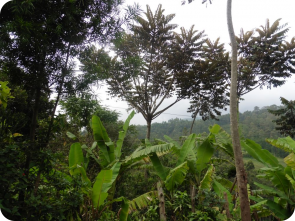Neuen Kommentar hinzufügen
Als ob im Kongo nicht alle Bäume einheimisch seien, die da wachsen! Nein, sind sie nicht. Seit Jahrzehnten wurden für Aufforstungen sogenannte exotische Bäume genommen, allen voran Eukalyptus. Herkunft: Australien. So wachsen jetzt in den Wäldern der LHL-Partner vorwiegend exotische Bäume heran (aber nur sehr wenig Eukalyptus). Doch die Partner wollen ihre Wälder in den nächsten Jahren "umbauen" und möglichst vorwiegend einheimische Arten anpflanzen. Zur Vorbereitung dieser Aktivitäten war im Januar ein Botaniker mit unseren Forstarbeitern unterwegs. Die Frage war, welche einheimischen Bäume finden sich sowohl in den Baumschulen als auch in den restlichen Naturwäldern, die in entlegenen Tälern übriggeblieben sind - in früheren Jahrzehnten und Jahrhunderten war die gesamte Region bewaldet. Die LHL-Partner bemühen sich den Sekundärwald wiederherzustellen und wollen in zunehmendem Masse einheimische Arten anpflanzen. So sind schon einige Baumschulen voller Setzlinge solcher einheimischen Arten - und bisher wußten die Baumschulgärtner nicht, welche Arten dies waren. Dies hat sich jetzt geändert. Der Botaniker Bonny Dumbo hat am Rande der Waldarbeiterausbildung, über die wir noch berichten werden, seine Forschungen angestellt. Hier das Ergebnis in seiner englischen Originalversion. Wir haben uns bemüht für alle Arten bei Wikipedia oder anderswo Referenzen mit Beschreibungen zu finden. Diese Nachforschungen sind hochinteressant, insbesondere weil vielen Bäumen, Blättern und Früchten auch heilende Wirkung zugesprochen wird.
REPORT MISSION JANUARY 2020
PURPOSE OF THE MISSION
Bonny Dumbo
The purpose of this mission was to observe the forest islands found in the sites (BUSINGA, NYANGEZI, MUSHENYI, KAZIBA, LUHWINDJA and BURHINYI), in order to have an idea on the species to which we can use to restore the forest habitat.
1. NYANGEZI January 14 to 15 We started in Nyangezi on 14.01. 2020 when we met Brother Jean Luc and ON explained to him the purpose of the mission which was to observe the forest islands found in the various sites above. After having had this interview with Jean Luc, we told him that we also wanted to meet with the sawyers and machinists of this sector and Jean Luc did not hesitate to put us in contact with these people.
In the morning of 13.01 we talked to the sawyers and machinists; the sawyers explained to us the different techniques that they use to fell or exploit the trees, which I had as constant and that taking into account the different techniques that these people use to fell and exploit the trees they still have an idea general on forestry despite not having studied. There I was only forced to learn a few technical forestry words necessary. When I finished with the sawyers, I spoke with the nurserymen and we went to visit their nursery which I unfortunately found in poor condition,
no maintenance (poorly maintained) and there I was obliged to explain them how to maintain a nursery by showing them the importance of the nursery in reforestation. After doing this interview with these people, I spoke with the machinists and here we all went to the Eucalyptus field and the sawyers, the machinists and nurserymen,
See PHOTOS To reach the ground I took the geographical coordinates of the middle: S: 026828.6, E: 0288696.9, Alt: 1494m, I observed the topography, I observed the ground, I also observed the undergrowth of the planting to see the plants there to get an idea of the species that we can integrate into it. The species that I found in the undergrowth of the plantation are the following:
Maesa lanceolata, https://en.wikipedia.org/wiki/Maesa_lanceolata
Erythrina abyssinica, https://en.wikipedia.org/wiki/Erythrina_abyssinica
Harunga madagascarensis, https://en.wikipedia.org/wiki/Harungana_madagascariensis
Anthocleista schweinfurthii, https://de.wikipedia.org/wiki/Anthocleista
Maesopsis eminii, https://de.wikipedia.org/wiki/Maesopsis_eminii
Markamia lutea, https://en.wikipedia.org/wiki/Markhamia_lutea
Albizia gummifera https://en.wikipedia.org/wiki/Albizia_gummifera + http://tropical.theferns.info/viewtropical.php?id=Albizia+gummifera
2. MUSHENYI from January 16 to 17 The first day in Mushenyi we started by bringing together our local people to plan how to go and visit the different forest islands found in the area. 17.01 in the morning We went to visit the nurseries and I congratulated these people a lot because they really understood and applied all that we learned about how to maintain a nursery.

Really congratulations on the nursery side to the people of Mushenyi. In the afternoon we went to visit the forest island of ZIRANGABO where I took the necessary items such as: S: 027578.8, E: 0287861.4, Alt: 2106m Forest type: secondary forest of:
Maesa lanceolata, https://en.wikipedia.org/wiki/Maesa_lanceolata
Galiniera coffeoides, https://plants.jstor.org/compilation/Galiniera.coffeoides +http://www.theplantlist.org/tpl1.1/record/kew-85554 + http://www.theplantlist.org/tpl1.1/record/kew-85556
Hagenia abyssinica https://en.wikipedia.org/wiki/Hagenia
Hypericum revoltum, https://en.wikipedia.org/wiki/Hypericum_revolutum
Erythrina abyssinica, https://en.wikipedia.org/wiki/Erythrina_abyssinica
Nuxid congesta, https://en.wikipedia.org/wiki/Nuxia_congesta
Anthocleista grandiflora, https://en.wikipedia.org/wiki/Anthocleista_grandiflora
Faurea saligna with many terrestrial orchids. https://en.wikipedia.org/wiki/Faurea_saligna
3. KAZIBA January 18 to 20
We started by visiting the IPE nursery which is also well maintained, really these people understood what we learned last time. After this visit we left to visit the NKOMA forest island which had the following geographic coordinates: S: 028310.9, E: 0288148.0, Alt: 1818m, secondary forest. Mujimbo Forest:
Bridelia micrantha, https://en.wikipedia.org/wiki/Bridelia_micrantha
Ficus alastica, https://en.wikipedia.org/wiki/Ficus_elastica
Nalubombo:
Xymalos monospora, https://en.wikipedia.org/wiki/Xymalos
Cihume:
Galiniera coffeoides, https://plants.jstor.org/compilation/Galiniera.coffeoides +http://www.theplantlist.org/tpl1.1/record/kew-85554 + http://www.theplantlist.org/tpl1.1/record/kew-85556
Mugarhe:
Syzygium guineense, https://de.wikipedia.org/wiki/Wasserbirne
Pittosperum mildbraedii, https://en.wikipedia.org/wiki/Pittosporum
Alangium chinense. https://en.wikipedia.org/wiki/Alangium_chinense
Buguguna:
Allophylus kivuensis, https://de.wikipedia.org/wiki/Allophylus
Macaranga kilimandcharica, https://www.gbif.org/species/3074220 + http://tropical.theferns.info/viewtropical.php?id=Macaranga+kilimandscharica + http://wcsp.science.kew.org/furtherInformation.do?name_id=116525
Sapium ellipticum, http://old.worldagroforestry.org/treedb2/speciesprofile.php?Spid=1487
Kabiranjouu:
Bersama abyssinica, https://en.wikipedia.org/wiki/Bersama_abyssinica
Prunus africana, https://en.wikipedia.org/wiki/Prunus_africana
Maesa lanceolata, https://en.wikipedia.org/wiki/Maesa_lanceolata
Albizia gummifera, https://en.wikipedia.org/wiki/Albizia_gummifera
Polyscias fulva, https://en.wikipedia.org/wiki/Polyscias + http://tropical.theferns.info/viewtropical.php?id=Polyscias+fulva
Ficus thonningii, https://en.wikipedia.org/wiki/Ficus_thonningii
Dracaeana, steudneri, https://de.wikipedia.org/wiki/Drachenb%C3%A4ume + http://de.hortipedia.com/Dracaena_steudneri
Dracaena afromontana https://plants.jstor.org/compilation/Dracaena.afromontana +

View the photo 19.01. Before me and Jules we went to visit the KAMANO forest island for the Bami which had the following geographic coordinates: S: 028558.8, E: 0288457.9, Alt: 2228m Mountain forest of:
Hagenia abyssinica, https://en.wikipedia.org/wiki/Hagenia
Sapium ellipticum, http://old.worldagroforestry.org/treedb2/speciesprofile.php?Spid=1487
Carapa grandiflora, https://plants.jstor.org/compilation/Carapa.grandiflora + https://en.wikipedia.org/wiki/Carapa
Chrysophyllum gorungosanum, http://tropical.theferns.info/viewtropical.php?id=Chrysophyllum+gorungosanum
Ilex mitis, https://en.wikipedia.org/wiki/Ilex_mitis
Symphonia globulifera, https://en.wikipedia.org/wiki/Symphonia_globulifera
Neoboutonia macrocalyx, http://www.theplantlist.org/tpl1.1/record/kew-133649 + https://uses.plantnet-project.org/en/Neoboutonia_macrocalyx_(PROTA)#Other_botanical_information
Macaranga kilimandscharica, https://www.gbif.org/species/3074220 + http://tropical.theferns.info/viewtropical.php?id=Macaranga+kilimandscharica + http://wcsp.science.kew.org/furtherInformation.do?name_id=116525
Harungana afromontana, https://en.wikipedia.org/wiki/Harungana
Strombasia scheffleri, http://tropical.theferns.info/viewtropical.php?id=Strombosia+scheffleri + https://en.wikipedia.org/wiki/Strombosia
Syzygium congested Nine, https://de.wikipedia.org/wiki/Syzygium_%28Gattung%29
Syzygium guaoni gaineiaaaifia giniia gaifia giniia giaiia giaiia giaiia giaiia giaiia giaiia gifnia giaiia giaiia giaiia giaiia giaiia giaiia giaiia giahia giifia giaffi nia giaffiia giaffi, nia revoltum,
Faurea saligna, https://en.wikipedia.org/wiki/Faurea_saligna
Parinari excelsa, https://en.wikipedia.org/wiki/Parinari_excelsa
Ocotea usambarensis, https://en.wikipedia.org/wiki/Ocotea_usambarensis
Myrianthus holstii, http://tropical.theferns.info/viewtropical.php?id=Myrianthus+holstii
Xymalos monospora, https://en.wikipedia.org/wiki/Xymalos + https://www.zimbabweflora.co.zw/speciesdata/species.php?species_id=123940
Garcinia buchananii, https://www.zimbabweflora.co.zw/speciesdata/species.php?species_id=140430
Pachystella brevipes, https://treesociety.org.zw/tree-life/54/ (cherche sur site!)
Africana volkensii. ???
In the afternoon we went to investigate
Polyscias fulva http://tropical.theferns.info/viewtropical.php?id=Polyscias+fulva
and we investigated Mr. BALIBUNO MBELI, 39 years old who is the owner of the plot where the species grows and we asked him a few questions: Scientific name of the species: Polyscias fulva Vernacular name: Mulangalanga Family: Araliaceae Age: 15 to 20 years old Circumference: 224 cm DBH: 71, 3 Height: 25m Ecological difficulty on the growth of the species: no ecological requirements, Wood color: white Wood consistency: light Board price on the market: 2 US for a normal drill What do you think is the fastest growing species between Polyscias fulva and Pinus patula? : Polyscias fulva Availability of seeds: Difficult to find Would you agree with LHL's intervention for the availability of seeds? : So okay Based on the height and its DBH can you estimate the money that can be drawn in once you exploit it? : 700 to 800 US NB: we asked this gentleman not to cut this tree to serve us seeds
4. LUHWINDJA January 20 We started by visiting the forest island of KISHALI in the morning which had the following geographic coordinates: S: 028234.2, E: 0287748.8, Alt: 1853 m Forest of:
Allophylus africanus (Kantindi), https://de.wikipedia.org/wiki/Allophylus
Flaucourtia indica (Inshugishugi), https://en.wikipedia.org/wiki/Flacourtia_indica
Ficus exasperata, https://en.wikipedia.org/wiki/Ficus_exasperata
Ficus thonningii (Mutundu), https://en.wikipedia.org/wiki/Ficus_thonningii
Erythrina abyssinica, https://en.wikipedia.org/wiki/Erythrina_abyssinica
Dracaena steudneri, http://de.hortipedia.com/Dracaena_steudneri
Prunus africana (Mumba), https://en.wikipedia.org/wiki/Prunus_africana
Ekebergia capensis (Mukalakaliai myrosediedi ), https://de.wikipedia.org/wiki/Ekebergia_capensis
Ochna holstii, https://www.zimbabweflora.co.zw/speciesdata/species.php?species_id=140200
Bersama abyssinica (Kabiranjovu), http://tropical.theferns.info/viewtropical.php?id=Bersama+abyssinica
Polyscias fulva (Mulangalalnga), http://tropical.theferns.info/viewtropical.php?id=Polyscias+fulva
Syzygium guineense, https://de.wikipedia.org/wiki/Wasserbirne
Bridelia micrantha (Mujimbu), https://de.wikipedia.org/wiki/Bridelia_micrantha
Clausena anisata, http://tropical.theferns.info/viewtropical.php?id=Clausena+anisata ; https://en.wikipedia.org/wiki/Clausena_anisata
Albizia gummifera, https://uses.plantnet-project.org/en/Albizia_gummifera_(PROTA)#Albizia_mainaea
Chrysophyllum gorungosanum (Mafuta), https://uses.plantnet-project.org/en/Chrysophyllum_africanum_(PROTA)#Chrysophyllum_gorungosanum
Celtis durandii, https://en.wikipedia.org/wiki/Celtis
Then in the afternoon we went to visit the forest island of MPEMBA which had the geographical coordinates: S: 028479.3, E: 0287508.1, Alt: 2092m
Primary forest of: Albiza gummifera, https://uses.plantnet-project.org/en/Albizia_gummifera_(PROTA)#Albizia_mainaea
Polyscias fulva, http://tropical.theferns.info/viewtropical.php?id=Polyscias+fulva
Sapium ellipticum, https://www.sciencedirect.com/science/article/pii/S2221169116306244 ;
https://www.uni-duesseldorf.de/home/en/hhu-information-centre/news/news-... ;
https://www.bluegnu.co.za/4180-jumping-seed-tree.php
Trema orientalis, https://en.wikipedia.org/wiki/Trema_orientalis
Pittosporum viridiflorum, http://tropical.theferns.info/viewtropical.php?id=Pittosporum+viridiflorum
Macaranga kilimandcharica, http://tropical.theferns.info/viewtropical.php?id=Macaranga+kilimandscha... ; http://www.theplantlist.org/tpl/record/kew-116525
Dracaena steudneri, http://de.hortipedia.com/Dracaena_steudneri
Erytrina abyssinica, https://en.wikipedia.org/wiki/Erythrina_abyssinica
Syzygium guineense, https://de.wikipedia.org/wiki/Wasserbirne
Xymalos monospora, https://en.wikipedia.org/wiki/Xymalos ; https://www.zimbabweflora.co.zw/speciesdata/species.php?species_id=123940
Bridelia micrantha, https://de.wikipedia.org/wiki/Bridelia_micrantha
Bersema abyssinea, http://tropical.theferns.info/viewtropical.php?id=Bersama+abyssinica
Ochna holstii, https://www.zimbabweflora.co.zw/speciesdata/species.php?species_id=140200
Faurea siligna, https://en.wikipedia.org/wiki/Faurea_saligna
Nuxia congesta, https://en.wikipedia.org/wiki/Nuxia_congesta; http://pza.sanbi.org/nuxia-congesta
5. BURHINYI January 20 We started by visiting their nursery this place and I can say that the Burhinyi nursery is the most maintained of all the nurseries in all the ones we visited. They were only identified with their species because they had a lot of unidentified species in their nursery. 22.01. We went to do some practices in planting Pinus patula on the different techniques to cut down a tree, after the session I asked them the age of the plantation they told me 15 years old.
This information gave me a comparison between Pinus patula and Polyscias fulva and I took the DHB of a Pinus in the plantation which was 33.7 and as height 18-20m. I asked the sawyers the value of this Pinus at the market they told me that this tree cannot exceed 80 US of planks at the market. Then I observed the undergrowth of the plantation where I found some species. After that we went to see the Mwami to give us permission to enter the sacred forest of Bami but unfortunately he did not authorize us due to atmospheric reasons but who was very happy with our ideas and who may want to work with us in order to restore the forest habitat of Burhinyi. In general I can say that the mission went well, the organization was good, no misunderstandings between us, we left and returned without any difficulty and we did everything as planned.













